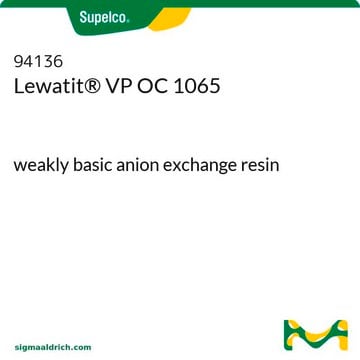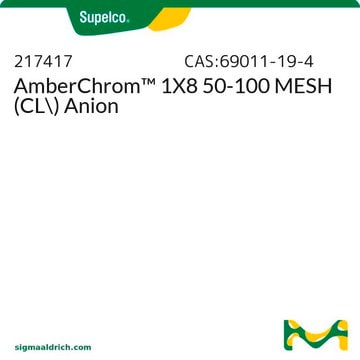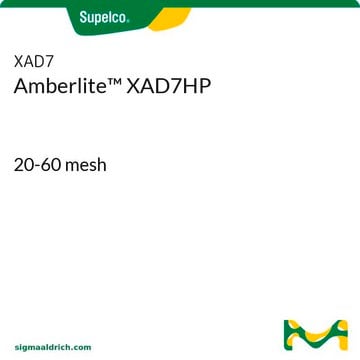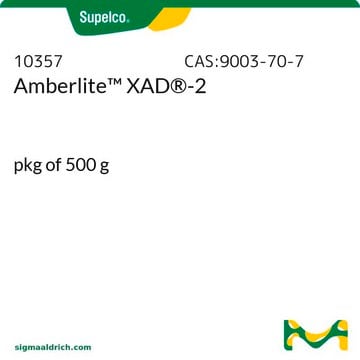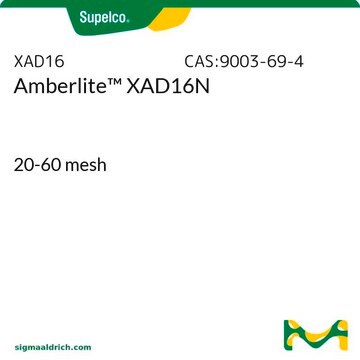62107
Lewatit® MonoPlus TP 214 Ion Exchange Resin
macroporous, 30-35 mesh
Anmeldenzur Ansicht organisationsspezifischer und vertraglich vereinbarter Preise
Alle Fotos(1)
About This Item
Empfohlene Produkte
product name
Lewatit® MonoPlus TP 214, ion exchange resin, macroporous
Qualitätsniveau
Form
macroporous
Feuchtigkeit
43-48%
Methode(n)
LPLC: suitable
Verlust
40-60% loss on drying, 110 °C
Matrix
styrene-divinylbenzene (macroporous)
Aktive Matrixgruppe
thiourea functional group
Partikelgröße
400-1250 μm
Kapazität
1.0 meq/mL by wetted bed volume
Trenntechnik
affinity
Verwandte Kategorien
Allgemeine Beschreibung
Lewatit MonoPlus TP 214 is a type of chelating ion-exchange resin.
Anwendung
Lewatit MonoPlus TP 214 may be used as a mercury-specific adsorber resin for the removal of mercury from contaminated groundwater samples prior to its determination by cold vapor atomic absorption spectrometry (CV-AAS). It may also be used as an ion-exchange resin for the determination of platinum and palladium in particles emitted from automobile exhaust catalysts prior to their analysis using cathodic adsorptive stripping voltammetry (CASV).
Ein chelatierendes Harz, besonders geeignet für das Entfernen von Metallen in hydrometallurgischen Prozessen und für die Extraktion/Wiedergewinnung von Quecksilber und Silber
Rechtliche Hinweise
Lewatit is a registered trademark of Lanxess Deutschland GmbH
Lagerklassenschlüssel
11 - Combustible Solids
WGK
WGK 3
Flammpunkt (°F)
Not applicable
Flammpunkt (°C)
Not applicable
Persönliche Schutzausrüstung
Eyeshields, Gloves, type N95 (US)
Choose from one of the most recent versions:
Besitzen Sie dieses Produkt bereits?
In der Dokumentenbibliothek finden Sie die Dokumentation zu den Produkten, die Sie kürzlich erworben haben.
Kimberly C Martin et al.
Journal of anatomy, 230(6), 766-774 (2017-04-04)
Branching morphogenesis of epithelia involves division of cells into leader (tip) and follower (stalk) cells. Published work on cell lines in culture has suggested that symmetry-breaking takes place via a secreted autocrine inhibitor of motility, the inhibitor accumulating more in
Determination of Pt and Pd in particles emitted from automobile exhaust catalysts using ion-exchange matrix separation and voltammetric detection.
Paraskevas M, et al.
Microchimica Acta, 176(1-2), 235-242 (2012)
Birga Soetje et al.
Frontiers in genetics, 11, 248-248 (2020-04-16)
Three-dimensional culture systems that allow generation of monolayered epithelial cell spheroids are widely used to study epithelial function in vitro. Epithelial spheroid formation is applied to address cellular consequences of (mono)-genetic disorders, that is, ciliopathies, in toxicity testing, or to
Tim N Koepp et al.
International journal of molecular sciences, 22(17) (2021-09-11)
The renal secretory clearance for organic cations (neurotransmitters, metabolism products and drugs) is mediated by transporters specifically expressed in the basolateral and apical plasma membrane domains of proximal tubule cells. Here, human organic cation transporter 2 (hOCT2) is the main
Wenlong Li et al.
Pharmaceutics, 13(11) (2021-11-28)
Repotrectinib shows high activity against ROS1/TRK/ALK fusion-positive cancers in preclinical studies. We explored the roles of multidrug efflux transporters ABCB1 and ABCG2, the OATP1A/1B uptake transporter(s), and the CYP3A complex in pharmacokinetics and tissue distribution of repotrectinib in genetically modified
Unser Team von Wissenschaftlern verfügt über Erfahrung in allen Forschungsbereichen einschließlich Life Science, Materialwissenschaften, chemischer Synthese, Chromatographie, Analytik und vielen mehr..
Setzen Sie sich mit dem technischen Dienst in Verbindung.